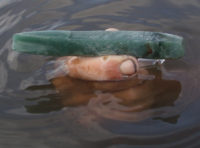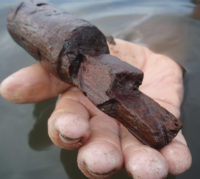 Archaeologists have unearthed a jadeite tool with a rosewood handle at a Maya salt works site in Belize. This is the first time the wooden handle of one of these tools has been found intact, preserved by the waterlogged mangrove peat at the Ek Way Nal site in southern Belize. It dates to the Maya Classic Period (300–900 A.D.) when the Paynes Creek Salt Works, a network of 110 ancient salt works operated in a mere three square mile area.
Archaeologists have unearthed a jadeite tool with a rosewood handle at a Maya salt works site in Belize. This is the first time the wooden handle of one of these tools has been found intact, preserved by the waterlogged mangrove peat at the Ek Way Nal site in southern Belize. It dates to the Maya Classic Period (300–900 A.D.) when the Paynes Creek Salt Works, a network of 110 ancient salt works operated in a mere three square mile area.
The jadeite of the gouger and the wood of the handle are very high-quality materials. The stone is translucent green, the most prized color of jadeite which ranges from translucent to opaque. The jadeite’s translucency is caused by the tight microstructure of its grains, which makes it much harder and more durable than the opaque versions of the stone. Its beauty and the high degree of difficulty in working it made translucent jadeite the preferred greenstone of Maya royalty. It is usually found in the tombs of the highest rank, like King Pacal’s tomb at Palenque, and at ceremonial sites where it was used in religious rituals and as diplomatic gifts. Grave goods of jewelry, carved plaques and statuary were important indicators of elite status.
 The hardness of the translucent jadeite that made it so desirable for royal adornment also made it desirable as a tool. The handle is Honduras rosewood, a dense, finely grained wood that even today is considered difficult to carve, so it too was a strong, sturdy material ideal for a tool.
The hardness of the translucent jadeite that made it so desirable for royal adornment also made it desirable as a tool. The handle is Honduras rosewood, a dense, finely grained wood that even today is considered difficult to carve, so it too was a strong, sturdy material ideal for a tool.
An analysis of the stone found that it is 98% jadeite by volume and that its quality and translucent blue-green shade approaches gem grade. That such expensive materials were used to make a utilitarian object like a gouger attests to the importance of salt in the Classic Maya economy, and the deep pockets of the salt workers themselves. They weren’t “working in the salt mines” in the modern sense of the idiom.
“The salt workers were successful entrepreneurs who were able to obtain high-quality tools for their craft through the production and distribution of a basic biological necessity: salt. Salt was in demand for the Maya diet. We have discovered that it was also a storable form of wealth and an important preservative for fish and meat,” said lead researcher and anthropologist Heather McKillop, who is the Thomas & Lillian Landrum Alumni Professor in the LSU Department of Geography & Anthropology.
The tool would not have been used to gouge hard materials like stone or wood. It was found in a salt kitchen, so researchers believe it was probably used in jobs like scraping salt, gutting calabash gourds, or cleaning fish or meat before salting.